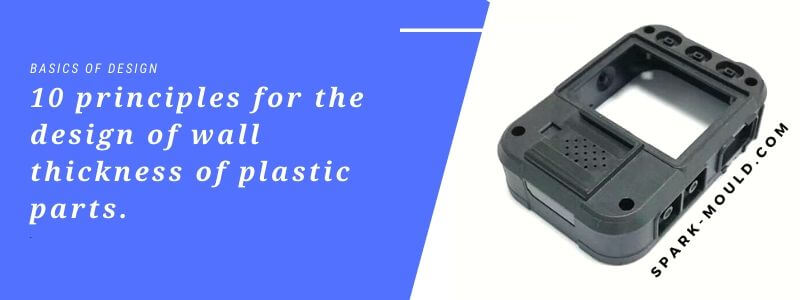
The wall thickness of plastic parts should meet the strength, stiffness and dimensional stability of plastic parts. Unreasonable wall thickness will affect the quality of the plastic parts. Increase production costs.
1.The wall thickness of the plastic part should be uniform.
Uneven wall thickness can result in inconsistent form fill and cooling shrinkage. Plastic parts have the risk of microcosm, bubbles, deformation and so on. If some of the wall thickness is inconsistent, problems such as shortage and dents may occur.
1)The wall thickness ratio of adjacent parts of the plastic part is strictly controlled to be 1: (1.5-2).
2)Where the wall thickness is too large, it can be changed to a hollow structure.
3)Reinforcing ribs can be used to increase strength.
2.The wall thickness of the plastic part should not be too thick or too thin.
When the plastic structure and the requirements of use are met, a smaller wall thickness is used as much as possible. This will allow the mold to cool quickly. And the weight of the plastic parts is small, saving materials and reducing costs.
But also consider the impact and vibration during the production process. Therefore should not be too thin.
3.The thickness of the inner wall of the plastic part should be less than the thickness of the outer wall. Otherwise, the plastic parts are prone to sink marks and dent.
4.The different wall thicknesses of plastic parts should gradually transition.
When the wall thickness of the plastic parts is different. Adjacent places should have enough transitional connections. Avoid sudden changes in size.
As Figure 4-1 (A) and Figure 4-2 (a).To reduce defects such as deformation and voids caused by different cooling rates.
The greater the wall thickness change, the greater the risk and the greater the internal stress. Where the wall thickness is poor, it should be smoothly transitioned. As Figure 4-1 (B) and Figure 4-2 (b-f).
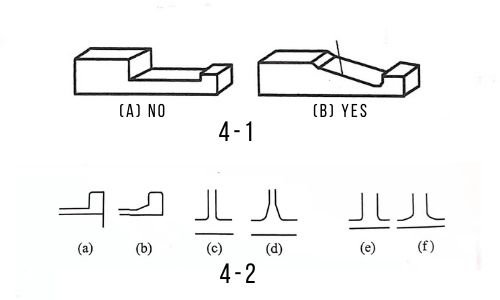
5.Avoid areas where thickness is concentrated.
In terms of shape, the portion where the thickness is concentrated is a portion where the thickness suddenly changes.
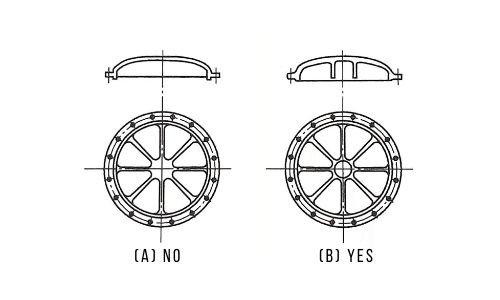
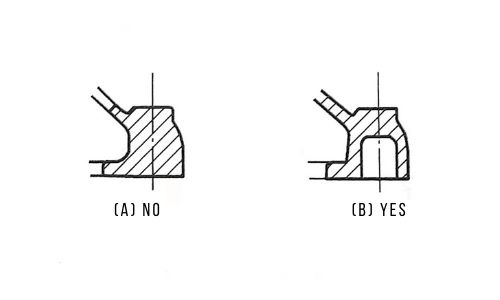
6.Set the appropriate plastic part wall thickness value.
Different plastics have different fluidity, so the wall thickness of plastic parts is also different.Some suggested values are listed in the table below.
| Plastic Material | Minimum | Small Product | Medium Product | Large Product |
|---|---|---|---|---|
| nylon(PA) | 0.45 | 0.76 | 1.5 | 2.4~3.2 |
| PE | 0.6 | 1.25 | 1.6 | 2.4~3.2 |
| Polystyrene (PS) | 0.75 | 1.25 | 1.6 | 3.2~5.4 |
| Modified Polystyrene | 0.75 | 1.25 | 1.6 | 3.2~5.4 |
| Plexiglass | 0.8 | 1.50 | 2.2 | 4~6.5 |
| RPVC | 1.2 | 1.60 | 1.8 | 3.2~5.8 |
| PP | 0.85 | 1.45 | 1.75 | 2.4~3.2 |
| Chlorinated Polyether | 0.9 | 1.35 | 1.8 | 2.5~3.4 |
| PC | 0.95 | 1.80 | 2.3 | 3~4.5 |
| Polyphenylene Ether(PPO) | 1.2 | 1.75 | 2.5 | 3.5~6.4 |
| Cellulose Acetate(CA) | 0.7 | 1.25 | 1.9 | 3.2~4.8 |
7.Thick-walled plastic parts have no application of inserts or assemblies to prevent deformation and shrinkage. Which is a wrong design.
8.Different parts are set with different wall thicknesses.
The design should take into account the thickness of the plastic part to the molding pressure.
1) As shown in Figure a. The plastic flows slowly at the handle. The wall thickness is appropriately increased at the handle to reduce the injection pressure.
2) As shown in Figure B. The molding time is shortened, which is beneficial to the molding of plastic parts.
3) Figure C and D are modified mold flow analysis pressure changes.
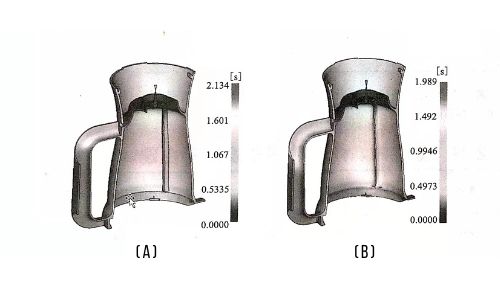
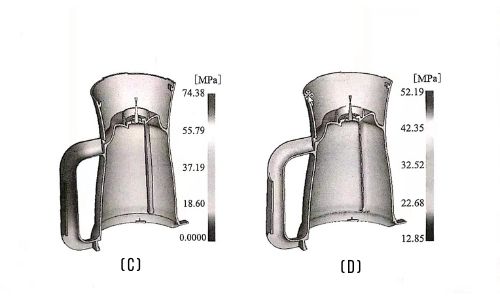
9.Consider the fluidity of plastic materials.
The flow characteristics of different plastics rational design thickness. The table below provides some recommended values.
| Plastic Material | Minimum | Small Product | Medium Product | Large Product |
|---|---|---|---|---|
| nylon | 0.45 | 0.76 | 1.5 | 2.4~3.2 |
| Polyphenylene | 0.6 | 1.25 | 1.6 | 2.4~3.2 |
| Polystyrene | 0.75 | 1.25 | 1.6 | 3.2~5.4 |
| High impact polystyrene | 0.75 | 1.25 | 1.6 | 3.2~5.4 |
| Plexiglass | 0.8 | 1.50 | 2.2 | 4~6.5 |
| Polyvinyl chloride | 1.2 | 1.60 | 1.8 | 3.2~5.8 |
| Polypropylene | 0.85 | 1.45 | 1.75 | 2.4~3.2 |
| Chlorinated Polyether | 0.9 | 1.35 | 1.8 | 2.5~3.4 |
| PC | 0.95 | 1.80 | 2.3 | 3~4.5 |
| Polyphenylene Ether(PPO) | 1.2 | 1.75 | 2.5 | 3.5~6.4 |
| Cellulose Acetate(CA) | 0.7 | 1.25 | 1.9 | 3.2~4.8 |
| Ethyl cellulose | 0.9 | 1.25 | 1.6 | 2.4~3.2 |
| Acrylic | 0.7 | 0.90 | 2.4 | 3.0~6.0 |
| POM | 0.8 | 1.40 | 1.6 | 3.2~5.4 |
| Polysulfone | 0.95 | 1.80 | 2.3 | 3~4.5 |
10.Avoid excessive thickness of the product.
Specially thick products can be designed to be hollow. And gas-assisted molding can be applied to avoid shrinkage.
At the end
Plastic parts need to be set to a reasonable wall thickness. The wall thickness should not be too thick or too thin. At the same time, the characteristics of the plastic material must also be considered.
These 10 guidelines can effectively avoid some misunderstandings. If you still have questions, please contact us.
